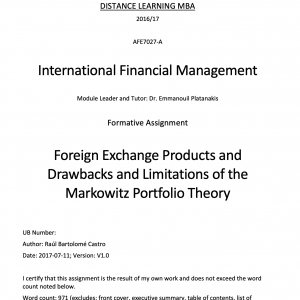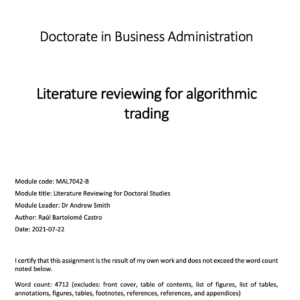Introduction
Algorithmic trading (AT) consists in computer algorithms, created by specialists, trading in stock markets autonomously. The first trading automation happened in March 1976 with the introduction of designated order turnaround (DOT) system in the New York Stock Exchange (NYSE) (Guerard 1990), which allowed routing orders electronically between trading centres.
Since its early introduction, AT is taking an increasing importance for investment banks, hedge funds, mutual funds, and alike. As reflect of this activity, in 2019 automatically managed funds were responsible of 35.1% of the equity traded in USA, equivalent to $31 trillion (Buchholz 2019). In 2020, the estimated global market for AT was $14 billion reaching $31.7 billion by 2027 (StrategyR 2022). Additionally, high-frequency trading (HFT), a particular case of AT characterized by daily trading, showed a growth of 164% from 2005 to 2010 in NYSE (Lin 2013), capturing in 2018 the 52% of the total equity traded in USA (Zaharudin et al. 2022). Given the proliferation and growth of AT, it also deserves sufficient academic attention. Though the phenomenon is prominent in textbooks (e.g., Chan (2017) or Hilpisch (2020a)) and thematically narrow in articles (e.g., Bowen and Hutchinson (2016) or Corbet et al. (2019) ), it is understudied holistically, which justifies this research proposal.
The topic presents many issues and angles. The mainstream of neoclassical finance supports efficient markets, therefore, trading strategies that do not capture market returns are doomed to underperform. However, behavioural finance argues that in many scenarios the markets are inefficient, opening opportunities to exploit them and beat the market. Secondly, institutional investors employ big human and capital resources to take advantage of AT, while retail investors have limited but growing opportunities. Thirdly, the number of AT trading strategies is big, tending to infinite assuming parameters change, that makes the selection of strategies challenging. Fourthly, investors are by nature idiosyncratic, and consequently does not exist one strategy valid for all.
The research question proposal pivots around the first dichotomy. Are there trading strategies that systematically present higher performance than the market? The question is studied using buy-and-hold strategy on S&P 500 as proxy of market returns versus three other strategies: pairs trading, oscillator of moving average (OsMA), and reversal in post-earnings announcement drift (PEAD).
The research goal is answering the research question conducting an empirical study of the four strategies using AT. Every strategy is backtested using historical financial data to obtain the key trading variables of are monthly return (, return of investment (ROI), maximum drawdown (MDD), annual standard deviation (SD), and Sharpe ratio (SR). The variables are used to evaluate the performance of each strategy and compare between them. If the market is efficient, any algorithmic strategy should not be able to outperform buy-and-hold, at least systematically over a long period of time.
This coursework is structured in seven main sections: theoretical underpinning, algorithmic trading, proposed research hypotheses, research methodology, DBA thesis timing plan, and conclusion. The theoretical underpinning section captures the neoclassical finance and behavioural finances. Algorithmic trading section covers mean-reverting strategies and momentum strategies. Proposed research hypotheses define the hypotheses testing for pairs trading, OsMA, and reversal in PEAD. Research methodology is a common chapter for all strategies, including backtesting and trading platform. Timing plan defines the tasks and duration of the DBA thesis. Finally, the conclusion chapter summarizes this coursework.
Content of the download
- Complete coursework in PDF format.
- Presentation used during the viva of the research proposal
€4,99




Reviews
There are no reviews yet.